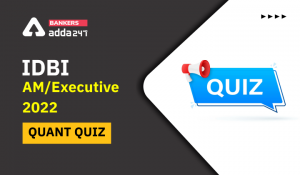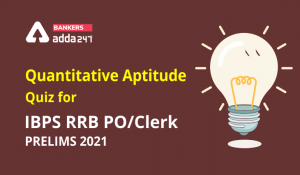Dear Students,
Numerical Ability for SBI Clerk Prelims 2018
Today is the Day 14 of the SBI Clerk 60 Days Study Plan and the topic for Today’s Numerical Ability Practice Questions is Based on Trains. Numerical Ability Section has given heebie-jeebies to the aspirants when they appear for a banking examination. As the level of every other section is only getting complex and convoluted, there is no doubt that this section, too, makes your blood run cold. The questions asked in this section are calculative and very time-consuming. But once dealt with proper strategy, speed, and accuracy, this section can get you the maximum marks in the examination. Following is the Numerical Ability quiz to help you practice with the best of latest pattern questions.
Q1. Two trains start at the same time from points A and B towards each other and after crossing each other, they take 25 hours and 9 hours in reaching points B and A, respectively. Find the ratio of speeds of 1st train to that of 2nd train.
(a) 5: 3
(b) 3: 5
(c) 4: 5
(d) 5: 4
(e) 5: 7
Q2. A train of length 250 metre, passes a platform of 350 metre length in 50 seconds. What time will this train take to pass a platform of 230 metre length?
(a) 50 sec
(b) 45 sec
(c) 40 sec
(d) 36 sec
(e) 54 sec
Q3. A man sees a train passing over a bridge 1 km long. The length of the train is half of the bridge. If the train clears the bridge in 2 minutes then the speed of the train is:
(a) 30 kmph
(b) 45 kmph
(c) 50 kmph
(d) 60 kmph
(e) 54 kmph
Q4. A train travelling at 48 kmph completely crosses another train having half its length and traveling in the opposite direction at 42 kmph in 12 seconds. What is the length of the longer train?
(a) 60 metre
(b) 100 metre
(c) 150 metre
(d) 200 metre
(e) 250 metre
Q5. A train travelling at a speed of 30 m/s crosses a 600 metres long platform in 30 seconds. Find the length of the train.
(a) 120 metre
(b) 150 metre
(c) 200 metre
(d) 300 metre
(e) 350 metre
Q6. Two trains running in the same direction at 58 kmph and 40 kmph, completely passes one another in 1 minute. If the length of the first train is 100 m, the length of the second train is:
(a) 125 metre
(b) 150 metre
(c) 175 metre
(d) 200 metre
(e) 240 metre
Q7. A train crosses a bridge of length 150 metre in 15 seconds and a man standing on it in 9 seconds. The train is travelling at a uniform speed. Length of the train is:
(a) 225 metre
(b) 200 metre
(c) 135 metre
(d) 90 metre
(e) 140 metre
Q8. Two trains of equal length are running on parallel lines in the same direction at 46 kmph and 36 kmph. The faster train passes the slower train in 36 seconds. The length of each train is:
(a) 82 metre
(b) 50 metre
(c) 80 metre
(d) 72 metre
(e) 90 metre
Q9. Excluding stoppages, the speed of a train is 108 kmph and including stoppages, it is 90 kmph. For how many minutes does the train stop per hour?
(a) 5
(b) 9
(c) 10
(d) 6
(e) 8
Q10. P and Q are 27 km away. Two trains having speeds of 24 kmph and 18 kmph respectively start simultaneously from P and Q travel in the same direction. They meet at a point R beyond Q. Distance of QR is:
(a) 126 km
(b) 81 km
(c) 48 km
(d) 36 km
(e) 54 km
Q11. If a train runs at 40 kmph, it reaches its destination late by 11 minutes. But if it runs at 50 kmph, it is late by 5 minutes only. The actual time (in minutes) for the train to complete the journey:
(a) 13
(b) 15
(c) 19
(d) 21
(e) 31
Q12. A train covers a distance of 10 km in 12 minutes. If its speed is decreased by 5 kmph, the time taken by it to cover the same distance will be:
(a) 10 minutes
(b) 13 minutes 20 second
(c) 13 minutes
(d) 11 minutes 20 second
(e) None of these
Q13. A train moves with a speed of 30 kmph for 12 minutes and for next 8 minutes at a speed of 45 kmph. Find the average speed of the train:
(a) 37.5 kmph
(b) 36 kmph
(c) 48 kmph
(d) 30 kmph
(e) 24 kmph
Q14. How much time does a train, 50 metres long, moving at 68 kmph take to pass another train, 75 metres long, moving at 50 kmph in the same direction?
(a) 5 seconds
(b) 10 seconds
(c) 20 seconds
(d) 25 seconds
(e) 30 seconds
Q15. A train M leaves Meerut at 5 am and reaches Delhi at 9 am. Another train N leaves Delhi at 7 am and reaches Meerut at 10.30 am. At what time do the two trains cross one another?
(a) 8:26 am
(b) 8 am
(c) 7:36 am
(d) 7:56 am
(e) None of these
(a) 5: 3
(b) 3: 5
(c) 4: 5
(d) 5: 4
(e) 5: 7
Q2. A train of length 250 metre, passes a platform of 350 metre length in 50 seconds. What time will this train take to pass a platform of 230 metre length?
(a) 50 sec
(b) 45 sec
(c) 40 sec
(d) 36 sec
(e) 54 sec
Q3. A man sees a train passing over a bridge 1 km long. The length of the train is half of the bridge. If the train clears the bridge in 2 minutes then the speed of the train is:
(a) 30 kmph
(b) 45 kmph
(c) 50 kmph
(d) 60 kmph
(e) 54 kmph
Q4. A train travelling at 48 kmph completely crosses another train having half its length and traveling in the opposite direction at 42 kmph in 12 seconds. What is the length of the longer train?
(a) 60 metre
(b) 100 metre
(c) 150 metre
(d) 200 metre
(e) 250 metre
Q5. A train travelling at a speed of 30 m/s crosses a 600 metres long platform in 30 seconds. Find the length of the train.
(a) 120 metre
(b) 150 metre
(c) 200 metre
(d) 300 metre
(e) 350 metre
Q6. Two trains running in the same direction at 58 kmph and 40 kmph, completely passes one another in 1 minute. If the length of the first train is 100 m, the length of the second train is:
(a) 125 metre
(b) 150 metre
(c) 175 metre
(d) 200 metre
(e) 240 metre
Q7. A train crosses a bridge of length 150 metre in 15 seconds and a man standing on it in 9 seconds. The train is travelling at a uniform speed. Length of the train is:
(a) 225 metre
(b) 200 metre
(c) 135 metre
(d) 90 metre
(e) 140 metre
Q8. Two trains of equal length are running on parallel lines in the same direction at 46 kmph and 36 kmph. The faster train passes the slower train in 36 seconds. The length of each train is:
(a) 82 metre
(b) 50 metre
(c) 80 metre
(d) 72 metre
(e) 90 metre
Q9. Excluding stoppages, the speed of a train is 108 kmph and including stoppages, it is 90 kmph. For how many minutes does the train stop per hour?
(a) 5
(b) 9
(c) 10
(d) 6
(e) 8
Q10. P and Q are 27 km away. Two trains having speeds of 24 kmph and 18 kmph respectively start simultaneously from P and Q travel in the same direction. They meet at a point R beyond Q. Distance of QR is:
(a) 126 km
(b) 81 km
(c) 48 km
(d) 36 km
(e) 54 km
Q11. If a train runs at 40 kmph, it reaches its destination late by 11 minutes. But if it runs at 50 kmph, it is late by 5 minutes only. The actual time (in minutes) for the train to complete the journey:
(a) 13
(b) 15
(c) 19
(d) 21
(e) 31
Q12. A train covers a distance of 10 km in 12 minutes. If its speed is decreased by 5 kmph, the time taken by it to cover the same distance will be:
(a) 10 minutes
(b) 13 minutes 20 second
(c) 13 minutes
(d) 11 minutes 20 second
(e) None of these
Q13. A train moves with a speed of 30 kmph for 12 minutes and for next 8 minutes at a speed of 45 kmph. Find the average speed of the train:
(a) 37.5 kmph
(b) 36 kmph
(c) 48 kmph
(d) 30 kmph
(e) 24 kmph
Q14. How much time does a train, 50 metres long, moving at 68 kmph take to pass another train, 75 metres long, moving at 50 kmph in the same direction?
(a) 5 seconds
(b) 10 seconds
(c) 20 seconds
(d) 25 seconds
(e) 30 seconds
Q15. A train M leaves Meerut at 5 am and reaches Delhi at 9 am. Another train N leaves Delhi at 7 am and reaches Meerut at 10.30 am. At what time do the two trains cross one another?
(a) 8:26 am
(b) 8 am
(c) 7:36 am
(d) 7:56 am
(e) None of these





 Quantitative Aptitude Quiz For IDBI AM/E...
Quantitative Aptitude Quiz For IDBI AM/E...
 Quantitative Aptitude Quiz For IBPS RRB ...
Quantitative Aptitude Quiz For IBPS RRB ...





